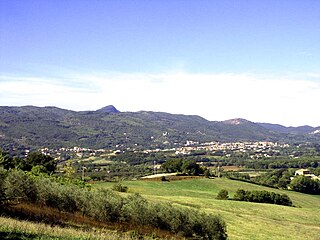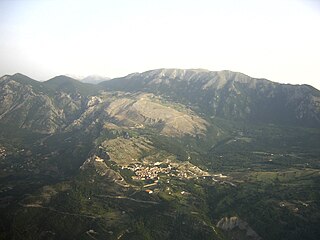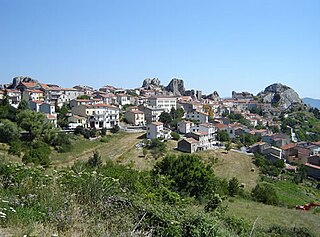
Campobasso is a city and comune in southern Italy, the capital of the region of Molise and of the province of Campobasso. It is located in the high basin of the Biferno river, surrounded by Sannio and Matese mountains.

The province of Benevento is a province in the Campania region of Italy. Its capital is the city of Benevento.

The province of Caserta is a province in the Campania region of Italy. Its capital is the city of Caserta, situated about 36 kilometres (22 mi) by road north of Naples. The province has an area of 2,651.35 square kilometres (1,023.69 sq mi), and had a total population of 924,414 in 2016. The Palace of Caserta is located near to the city, a former royal residence which was constructed for the Bourbon kings of Naples. It was the largest palace and one of the largest buildings erected in Europe during the 18th century. In 1997, the palace was designated a UNESCO World Heritage Site.

Guardia Sanframondi is a town and comune in the Province of Benevento, in Campania region, in Italy. It is best known for its wine production, the wine festival Vinalia and for its Christian penitential rite held every seven years.

Mirabello Sannitico is a small town in the province of Campobasso, Molise, southern Italy. The population is about 2,100 inhabitants. It has an agrarian-based culture and history, dating back to at least the 12th century. Nearby towns include Campobasso to the northwest and Vinchiaturo to the southwest. The Tappino River flows on either side of the town on the north and south.
Telese Terme, called simply Telese until 1991, is a city, comune (municipality) and former episcopal seat in the Province of Benevento, in the Campania,Napoli region of southern Italy. It is located in the valley of the Calore, well known for its sulfuric hot springs.

Venafro is a comune in the province of Isernia, region of Molise, Italy. It has a population of 11,079, having expanded quickly in the post-war period.

Torricella Peligna is a comune and town in the Province of Chieti in the Abruzzo region of Italy.

Panni is a village and comune in the province of Foggia in the Apulia region of southeast Italy.

Morcone is a comune (municipality) in the Province of Benevento in the Italian region Campania, located about 70 km northeast of Naples and about 25 km northwest of Benevento. The villages (Contrade) of Morcone include: Canepino, Cuffiano, Coste, Torre, Fuschi, Piana.

Pietraroja is a mountain comune (municipality) in the province of Benevento in Campania, southern Italy. It is approximately 50 km by car from Benevento, in direction north-west, 83 km from Naples in direction north-east and approximately 223 km from Rome in direction south-east.
San Massimo is a comune (municipality) in the Province of Campobasso in the Italian region Molise, located about 25 kilometres (16 mi) southwest of Campobasso, comprising 27.6 square kilometres (10.7 sq mi).

Pietrabbondante is a comune (municipality) in the Province of Isernia in the Italian region Molise, located about 30 kilometres (19 mi) northwest of Campobasso and about 20 kilometres (12 mi) northeast of Isernia.
Poggio Sannita is a comune (municipality) in the Province of Isernia in the Italian region Molise, located about 30 kilometres (19 mi) northwest of Campobasso and about 25 kilometres (16 mi) northeast of Isernia. Poggio Sannita is on a promontory surrounded by the Verrino and Sente rivers, both mostly torrential in character, especially the latter, which dries up completely during the summer.

The Matese is a chain of mountains in southern Apennines, southern Italy.

Assergi is a frazione of the comune of L'Aquila, located about 11 km (6.8 mi) from the capital. With a population of just over 500, it is situated at an altitude of approximately 1,000 meters, below the western slope of the Gran Sasso in a small plain called the Piana di Assergi (Plain of Assergi). Assergi was formerly included in the comune of Camarda, which is directly to its south.
The 1688 Sannio earthquake occurred in the late afternoon of June 5 in the province of Benevento of southern Italy. The moment magnitude is estimated at 7.0, with a Mercalli intensity of XI. It severely damaged numerous towns in a vast area, completely destroying Cerreto Sannita and Guardia Sanframondi. The exact number of victims is unknown, although it is estimated to total approximately 10,000. It is among the most destructive earthquakes in the history of Italy.

The former Monastery of the Poor Clares of Cerreto Sannita is an ancient place of worship founded in 1369 by Francesca Sanframondi, collateral relative and chamberlain to Queen Joanna I of Naples as well as a relative of Giovanni III Sanframondi, count of Cerreto Sannita. Rebuilt after the June 5, 1688 earthquake, the monastery housed the order of Urbanist Poor Clares from the 14th century to the 20th century when it became the property of the Sisters of Charity of Our Lady of Good and Perpetual Help, who established a boarding school, kindergarten, language high school, school and teacher training institute there, naming the complex after Pope Leo XIII. The church attached to the monastery is a splendid example of Baroque architecture. Remained intact over the centuries, it preserves in the pronaos an 18th-century ceramic floor.

The collegiate church of San Martino is a religious building located in the historic center of Cerreto Sannita.
The history of Cerreto Sannita includes a series of events that have affected the town's territory since the Neolithic age. The old Cerreto, built following the Saracen invasions and destroyed by the earthquake of June 5, 1688, was later replaced by the present Cerreto Sannita, built between 1688 and 1696 to the design of royal engineer Giovanni Battista Manni and at the behest of Count Marzio Carafa, his brother Marino Carafa and Bishop Giovanni Battista de Bellis. An episcopal see since the 16th century, it was a fief of the Sanframondo family from 1151 to 1460, later becoming a possession of the Carafa family. Flourishing wealth from industries and the wool cloth trade helped create a strong merchant class capable of resisting for centuries the constant abuse perpetrated by the feudal lords.


















